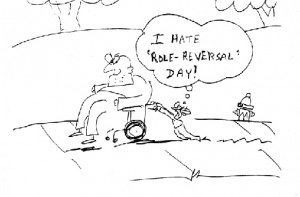Crippled!
If journalism's job is to afflict the comfortable, then why is disability media so focused on comforting the afflicted?
Most of us remember Vancouver mayor Sam Sullivan accepting the flag at the closing ceremonies of the Turin Winter Olympics in February 2006. The flag slotted perfectly at Sullivan’s side as he spun his wheelchair eight times to a roaring standing ovation. That moment in the spotlight made Sullivan a darling of international media. They jumped at the chance to tell his story of perseverance, from a man who became a quadriplegic – with suicidal thoughts – as a result of a skiing accident at age 19 to the first quadriplegic mayor of a North American city.
Unfortunately for Vancouver, that was the highlight of Sullivan’s leadership. Since then, he’s been accused of using his wheelchair as a political tool to create the appearance of gee-golly-gosh innocence. Few city councillors have criticized him publicly for poor decisions, such as the time he assigned the homelessness file to the rookie councillor who proposed the creation of 100-square-foot dorm-style units – significantly smaller than the 400 square feet required under city bylaws. “How do you knock a guy in a wheelchair?” says Globe and Mail columnist Gary Mason, referring to the challenge faced by Sullivan’s political opponents. Still, Mason and others have treated Sullivan like any other politician, reporting that behind closed doors Sullivan has been called “feckless” and “wishy-washy.”
You wouldn’t know any of this if you read the summer 2006 interview with Sullivan in Abilities magazine, which celebrated his status as Canada’s first disabled mayor. The conversation addressed his history of taking advantage of the social welfare system, but neglected to mention his history of bending the rules in order to gain funding. In one case, he needed an assistant to type for him and help him move around, but there was not enough money. Since his assistant was disabled, he secured the salary through a disability support program, though he has admitted the assistant’s disability wouldn’t normally qualify for funding. When asked about his agenda for the disabled community, he dodged the question and the magazine didn’t press him further. The only truly controversial issue the Q&A touched on was his opinion that drug addiction is as much a disability as his own.
As one of Ryerson University’s few disabled journalists – and someone who has experience being a cymbal monkey for charity-I tend to smell stereotype from a mile away. “I’ve got some really inspirational people lined up for this article,” says Toronto Star education reporter Daniel Girard, who’s questioning me for a story he’s writing about why more disabled students are entering college and university. The interview isn’t two minutes old and alarm bells are ringing. His focus seems to be heading into the land of superhero narrative, a common treatment of disabled sources.
Thankfully, Girard didn’t take that route. In a sidebar article, he wrote about one woman who is a PhD candidate and has earned an estimated $250,000 in scholarships-something most people without disabilities can’t accomplish, never mind someone living with dyslexia and dysgraphia. Like the Vancouver reporters following Sullivan’s political performance, Girard didn’t play it safe. He made it clear that even though universities have done a lot to accommodate students with disabilities, more change is needed. He outlined, for example, one University of Toronto professor’s complaint that the criminology faculty building is not accessible because it is not a high priority.
Unfortunately, tougher journalism is missing from magazines, television shows and websites that cater to people with disabilities. Instead, Canadian disability media are dominated by service pieces, positive profiles and opinion columns that ignore issues such as abuse from attendants, isolation and cuts to government support. The lack of in-depth reporting silences any critical voice in the disabled community, and doesn’t hold organizations and government accountable.
Other factors make it difficult for reporters to get the story. Many with disabilities stay silent for fear they’ll lose access to government programs and services. Division within the community prevents issues from coming to light. And the biggest problem is money, both the lack of funding and the need to appease advertisers, organizations and governments. Disability media outlets are so fragile that maintaining financial stability takes all the energy they have. But simply existing isn’t enough -without investigative journalism, disability media do nothing to illuminate important issues that could potentially inspire activism from the disabled population.
Crippled2 When it comes to disability media, there are not a lot out there. CBC leads the pack, producing issue-focused content as part of its public broadcasting responsibility to represent minorities. Mostly, this is fulfilled by Moving On, a 13-episodes-per-year documentary series. In 2005, the broadcaster also launched a monthly online column, Disability Matters, but it did not survive budget cuts. Helen Henderson covers disability issues four times a month in her Star column, and disability-related stories occasionally appear in major newspapers, newsmagazines and national newscasts. Halifax’s Eastern Views is the country’s only significant online disability news source.
The now-defunct magazine Ability Network was published between 1992 and 1998. Launched by Spencer Bevan-John, a Nova Scotia paraplegic fed up with disability media’s soft coverage, it had a circulation of more than 20,000 and lasted 26 issues. It was the first magazine in Canada written by people with a wide range of disabilities telling their stories from a politically-charged perspective. For the most part, no organizations or government programs contributed editorial content, allowing Bevan-John to tackle taboo issues such as discrimination within the community and the tendency of organizations to take care of themselves before the people they serve. Bevan-John says the financial fallout from the magazine’s muckraking was a major reason for its downfall: “I couldn’t get charitable status. Revenue Canada felt we were doing something a little stronger than advocating.”
Bevan-John was also turned down by organizations that support Abilities, his one-time competitor and now the country’s only disability magazine. I contribute to Abilities, and have to admit I was shocked at how inaccessible its offices were the first time I went to visit editor-in-chief and publisher Raymond Cohen. Tucked at the end of a hall behind a heavy manual door, I found Cohen, a broad-shouldered man built like an orderly, offering compassion and a firm handshake. Cohen told me the inspiration for his magazine came to him while working for the Dr. Gordon Townsend School at the Alberta Children’s Hospital, an elementary and secondary school for disabled students receiving care. He was leading a parents’ group when he realized children receive information and support while at the hospital but there was nothing for them once they graduated. He committed himself to providing them, in the words of the magazine’s mission statement, “information, inspiration and opportunity.”
Since 1988, Abilities has provided a combination of lifestyle and service pieces four times annually. The magazine has a controlled circulation of about 45,000 and, through its parent company the Canadian Abilities Foundation, has obtained the charitable status Bevan-John so coveted. In addition to the magazine, the foundation maintains the country’s largest disability resource website and provides a range of self-help literature. Despite these strengths, many readers and contributors believe Abilities suffers from journalistic weakness.
“Accessibility is a common theme,” says Ed Smith, humour columnist for the St. John’s Telegram, former contributor to Disability Matters and best-selling author of From the Ashes of my Dreams – a book about living with a disability. “But it hasn’t been explored to the extent that shows how people like me are almost totally housebound. We can’t get into the homes of our friends or sometimes even our relatives.” Other controversial issues are ignored. “I haven’t seen anyone describe the effects on the spouse of someone with a major disability,” continues Smith. “Why do so many such relationships end up on the rocks? There is counselling for the disabled, but what about the spouse and the really personal issues, such as sex and intimacy and how to deal with those losses or substitute for them?”
I’ve had my own experience with tame content. I wrote an article for Abilities in the summer of 2006 about inaccessible public transportation, but the end result was only an overview, which lacked analysis. Cohen and managing editor Jaclyn Law believed this was the best way to tell the story, yet it didn’t offer solutions or hold providers accountable. Frequent Abilities contributor and freelance writer Anna Quon puts it bluntly: “I want Harper’s for people with disabilities.”
As a quarterly, it’s difficult for Abilities to cover news. Cohen says it has taken positions in favour of stem cell research and medicinal marijuana, but overall its editorial space is dominated by lifestyle pieces. Ing Wong-Ward, a producer at CBC Radio’s Here and Now who occasionally writes for Abilities, compares it to Chatelaine: “The majority of the magazine is how to deal with your husband and the latest spring fashions,” she says of Chatelaine. “There is nothing wrong with that, but at the same time I wouldn’t call it journalism.”
Cohen says he understands these complaints and believes his magazine should be more issue driven. In the past, theme issues and service journalism were the best ways to serve his readership, but now he thinks fundamental changes are needed for his magazine to broaden its reach. “We’ve helped break down stereotypes to the point where, these days, the way Abilities has been is less of a necessity,” he says. Cohen says he now wants the magazine to get “edgier” and more political, but how this might be funded remains an issue.
Production costs for each issue of Abilities are around $50,000 and the combined revenue from advertising and subscriptions hardly covers that amount. The magazine needs government grants to put the magazine in the black. Only on rare occasions has the magazine paid for itself through the Canadian Abilities Foundation’s commercial publishing ventures, and advertising on Enablelink and its access guide. The magazine also heavily relies on advertorial contributions from various disability organizations in its clearly-labelled Forum section, but none of that comes close to the $200,000 in funding it used to receive regularly from the Office of Disability Issues through the Ministry of Human Resources and Social Development – funding that was denied last fall. “Given today’s political climate, we no longer have access to the funding sources we used to,” Cohen said in October 2006. “This magazine could die at any time.” By late November, he had laid off five employees, including Law, his managing editor. In late December, an organization called Friends of the Canadian Abilities Foundation, made up of disability, equity and business executives, appealed to subscribers for speedy $100 minimum donations. The response was respectable but not overwhelming.
Even before the magazine went on life support, it was criticized for being too preoccupied with survival and tied too closely to disability and government organizations to focus on Cohen’s goal of meaningful journalism. Case in point: Last fall, Abilities ran an Easter Seals advertorial about the Access 2 Entertainment card, a pass designed in collaboration with Cineplex Entertainment LP and the Motion Picture Theatre Associations of Canada, that allows a disabled person’s attendant to go to movies at a discount or at no charge. “Some of this stems from a human rights complaint and nowhere have I seen the guy who initiated the complaint called,” says Wong-Ward. “It’s a bit disingenuous to just do an article saying, ‘Isn’t this great?'” Cohen was on the committee that created the pass and says there was no case that spawned it, but rather a long-standing rift between theatres and the community. “This was a rare good-news story,” he says, “with a lot of good faith being demonstrated on both sides.” The problem is that Abilities just let its advertisers cover the story in its Forum section, instead of doing original reporting. Cohen rejects the notion that he plays it safe to keep advertisers from pulling out, as they did with Ability Network. “It would have to be pretty outrageous for that to happen, and I don’t think the [edgier] issues are outrageous-I see these issues as important.”
Aside from financial problems, Cohen says a tepid response from readers is also to blame. “I see this as a sandwich generation,” he explains, “where many people still have an institutional frame of reference that says, ‘I’d like someone else to make the decisions.'” He may have a point-there is a fear that pushing against the status quo risks benefits such as attendant care, assisted living and financial support. This makes it difficult for journalists to get their sources to open up. “It’s the classic ‘don’t bite the hand that feeds you,'” Wong-Ward says.
There are also divisions about how to approach issues. “Hatred brews because of the feeling that you’re not as disabled as I am,” says visually-impaired Toronto web designer Lorne Marin, “so how can you speak for me when you have no idea what I’m going through?” There is also debate on how to inspire significant change. Montreal freelancer Hélèna Katz, who contributed to Disability Matters and writes for The Gazette in Montreal, has a visual impairment that is not immediately apparent. It’s a position that allows her to disclose her disability at her discretion. “On one hand, people see me as a regular person and my disability doesn’t define me,” she says. “On the other, people don’t realize why I do things a different way.” Katz believes change is best achieved through sharing personal stories, not through aggressive lobbying and activism. “If people are seeing me in the flesh they see I have a disability,” she says, “but they also see I’m a little bit like them too.”

Changing attitudes through positive examples and personal stories is the basis for CBC’s Moving On, an approach that is markedly different from its predecessor’s. When Disability Network, a pioneering disability-centred weekly news magazine, debuted in 1990, it reported on advocacy groups, ran profiles and became the prime source for the national disability community. Its approach was intentionally controversial, whereas the newer program isn’t. “There was a decision made, in the early days of the program, that it would more likely be attractive to viewers if it showed people with disabilities doing what people do, rather than hammering them over the head with a message,” says Moving On’s executive producer Doug Caldwell. “This type of journalism is more subtle, it is not pegged to the daily news agenda, quite consciously not.”
Host Joanne Smith says she was stopped in the street by someone who told her she was tired of people with disabilities being portrayed as activists. She feels Moving On’s current lifestyle documentary format is more conducive to creating change among the show’s predominately able-bodied audience. Smith says Moving On shows people being active, whereas in the past it was more like radio on television, with everyone sitting behind a desk. Besides, producing news pieces is expensive, although the show has had some success co-producing shows with The National. Last year, Smith started researching a story about two sisters travelling to China for an experimental stem cell surgery to increase their mobility.
The only medium where money doesn’t necessarily stand in the way of investigative journalism is the Internet. Eastern Views, started by editor Ralph Ferguson in 2005, covers organizations, government policy and events and provides the kind of up-to-the-minute coverage print publications can’t. Even though it is less beholden to advertisers and sponsors, it still doesn’t run much in-depth reporting.
Down south in Louisville, Kentucky is a more encouraging example. Since 1997, Ragged Edge Online has covered topics such as assisted suicide and abusive attendants. Unfortunately, editor Mary Johnson says the site has had to use fewer writers and will have to switch to a blog format. Again, money played a role, but Johnson says she’s also delivering more of what her readers want, which is issue-driven commentary. The rants, because of their unbridled nature, tend to be the most popular pieces on the site. “We’re not part of any organization,” she says, “so we can pretty much say what we want.”
Saying what you want is important, but so is investigative journalism in a community that struggles for equality. Ideally, this will motivate readers to action. But as long as a lack of funding is the main issue, no outlet will be able to deliver the complete package of news, investigation and opinion. If Abilities can’t hang on and does collapse, maybe it will spur writers, editors and publishers to wake up to the powerful journalism Cohen aspires to. In order for such efforts to succeed, bureaucrats and advertisers mustn’t interfere and let the disabled community tell the real stories.














